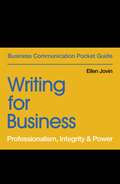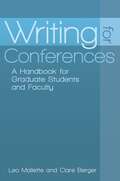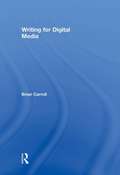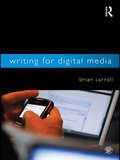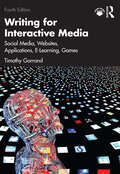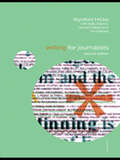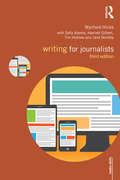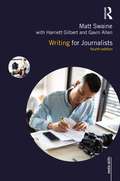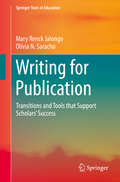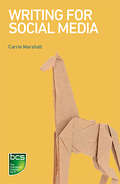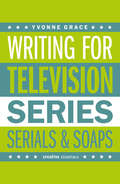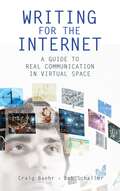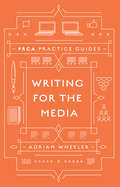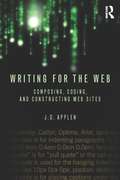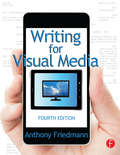- Table View
- List View
Writing for Business: Professionalism, Integrity & Power (Business Communication Pocket Guides)
by Ellen JovinBuild essential skills and write with confidence at work! Immediately practical guide to better business writing designed to help you develop a clear, direct, natural communication style that supports rather than obscures what you want to say. Writing for Business covers writing principles that are relevant for a wide range of business documents, including email, letters, memos, reports, proposals, and more, while also offering editing tips to ensure you come across as professional and polished. The book features examples and tips straight from the workplace.
Writing for Conferences: A Handbook for Graduate Students and Faculty
by Leo A. Mallette Clare BergerThis book answers every question a doctoral graduate new to publishing could have about writing for a conference, from "Why would I want to publish at a conference?" to "What do I wear?"Conferences are often a researcher's first foray into publishing. Each year, about 50,000 new doctoral graduates arrive to the publishing landscape, most with little or no understanding of how the conference publication process works. Yet until now, there have been no publications devoted to this specific subject.Writing for Conferences: A Handbook for Graduate Students and Faculty serves as an essential guide for graduate students who want to publish the results of the research projects of their graduate program to maximum effect. It explains the conference publication process step-by-step and answers all of the questions asked by students inexperienced in publishing. The book is also a valuable reference manual for previously published authors, providing insightful sections on ethics in publishing, dress and grooming, presentation tips, and networking techniques to develop further research and career opportunities.
Writing for Digital Media
by Brian CarrollThis work teaches students how to write effectively for online audiences while providing them with a solid understanding of the ways that the Internet has blurred traditional roles of media producer, consumer, publisher, and reader. 9780415992015 9780203894316
Writing for Digital Media
by Brian CarrollWriting for Digital Media teaches students how to write effectively for online audiences—whether they are crafting a story for the website of a daily newspaper or a personal blog. The lessons and exercises in each chapter help students build a solid understanding of the ways that the Internet has introduced new opportunities for dynamic storytelling as digital media have blurred roles of media producer, consumer, publisher and reader. Using the tools and strategies discussed in this book, students are able to use their insights into new media audiences to produce better content for digital formats and environments. Fundamentally, this book is about good writing—clear, precise, accurate, filled with energy and voice, and aimed directly at an audience. Writing for Digital Media also addresses all of the graphical, multimedia, hypertextual and interactive elements that come into play when writing for digital platforms. Learning how to achieve balance and a careful, deliberate blend of these elements is the other primary goal of this text. Writing for Digital Media teaches students not only how to create content as writers, but also how to think critically as a site manager or content developer might about issues such as graphic design, site architecture, and editorial consistency. By teaching these new skill sets alongside writing fundamentals, this book transforms students from writers who are simply able to post their stories online into engaging multimedia, digital storytellers. For additional resources and exercises, visit the Companion Website for Writing for Digital Media at: www.routledge.com/textbooks/9780415992015.
Writing for Digital Media
by Brian CarrollWriting for Digital Media teaches students how to write effectively for online audiences—whether they are crafting a story for the website of a daily newspaper or a personal blog. The lessons and exercises in each chapter help students build a solid understanding of the ways that the Internet has introduced new opportunities for dynamic storytelling as digital media have blurred roles of media producer, consumer, publisher and reader. Using the tools and strategies discussed in this book, students are able to use their insights into new media audiences to produce better content for digital formats and environments. Fundamentally, this book is about good writing—clear, precise, accurate, filled with energy and voice, and aimed directly at an audience. Writing for Digital Media also addresses all of the graphical, multimedia, hypertextual and interactive elements that come into play when writing for digital platforms. Learning how to achieve balance and a careful, deliberate blend of these elements is the other primary goal of this text. Writing for Digital Media teaches students not only how to create content as writers, but also how to think critically as a site manager or content developer might about issues such as graphic design, site architecture, and editorial consistency. By teaching these new skill sets alongside writing fundamentals, this book transforms students from writers who are simply able to post their stories online into engaging multimedia, digital storytellers. For additional resources and exercises, visit the Companion Website for Writing for Digital Media at: www.routledge.com/textbooks/9780415992015.
Writing for Digital Media (PDF)
by Brian CarrollThis work teaches students how to write effectively for online audiences while providing them with a solid understanding of the ways that the Internet has blurred traditional roles of media producer, consumer, publisher, and reader. 9780415992015 9780203894316
Writing for Interactive Media: Social Media, Websites, Applications, e-Learning, Games
by Timothy GarrandThis thoroughly revised fourth edition teaches students and professionals how to create interactive content for all types of new media and become successful writers or designers in a variety of fields.This comprehensive guide is grounded in the core principles and skills of interactive media writing, in which writers create text and structure content to guide users through interactive products such as websites or software. The book examines case studies on interactive formats including complex informational websites, computer games, e-learning courses, training programs, and immersive exhibits. These case studies assess real-world products and documentation used by professional writers such as scripts, outlines, screenshots, and flowcharts. The book also provides practical advice on how to use interactive media writing skills to advance careers in the social media, technical, instructional communication, and creative media fields. This edition includes new chapters on UX Writing and Content Design, Social Media Writing, and Writing for Mobile.Writing for Interactive Media prepares students for the writing challenges of today’s technology and media. It can be used as a core textbook for courses in UX Writing, Writing for Digital Media, and Technical and Professional Communication and is a valuable resource for writing professionals at all levels.Supplemental resources include a sample syllabus, class assignments, student exercises, scripts, outlines, flowcharts, and other interactive writing samples. They are available online at www.routledge.com/9781032554242
Writing for Interactive Media: Social Media, Websites, Applications, e-Learning, Games
by Timothy GarrandThis thoroughly revised fourth edition teaches students and professionals how to create interactive content for all types of new media and become successful writers or designers in a variety of fields.This comprehensive guide is grounded in the core principles and skills of interactive media writing, in which writers create text and structure content to guide users through interactive products such as websites or software. The book examines case studies on interactive formats including complex informational websites, computer games, e-learning courses, training programs, and immersive exhibits. These case studies assess real-world products and documentation used by professional writers such as scripts, outlines, screenshots, and flowcharts. The book also provides practical advice on how to use interactive media writing skills to advance careers in the social media, technical, instructional communication, and creative media fields. This edition includes new chapters on UX Writing and Content Design, Social Media Writing, and Writing for Mobile.Writing for Interactive Media prepares students for the writing challenges of today’s technology and media. It can be used as a core textbook for courses in UX Writing, Writing for Digital Media, and Technical and Professional Communication and is a valuable resource for writing professionals at all levels.Supplemental resources include a sample syllabus, class assignments, student exercises, scripts, outlines, flowcharts, and other interactive writing samples. They are available online at www.routledge.com/9781032554242
Writing for Journalists (Media Skills)
by Wynford Hicks Sally Adams Harriett Gilbert Tim HolmesPraise for the first edition: 'There are books that are badly written, books that are well written and books that you wish you'd written. This is one of the latter. Hicks and his co-writers produce a book that is a joy to read and is packed full of helpful advice.' – Chris Frost, Journalist 'You don't have to be a journalist to read this book. Anyone with an interest in improving their writing skills and developing a sense of good style will find it useful Wynford Hicks takes a no-nonsense, sleeves rolled up approach to writing which has no time for preciousness.' – Roy Johnson, Mantex'Writing for Journalists neatly fills a gap in the market for a no-nonsense book for trainees written by trainers who genuinely understand the industry and who have moved with the times.' – Sharon Wheeler, Journalism Studies Writing for Journalists is about the craft of journalistic writing: how to put one word after another so that the reader gets the message – or the joke – goes on reading and comes back for more. It is a practical guide for all those who write for newspapers, periodicals and websites, whether students, trainees or professionals. This revised and updated edition introduces the reader to the essentials of good writing. Based on critical analysis of news stories, features and reviews from daily and weekly papers, consumer magazines, specialist trade journals and a variety of websites, Writing for Journalists includes: advice on how to start writing and how to improve and develop your style how to write a news story which is informative, concise and readable tips on feature writing from researching profiles to writing product round-ups how to structure and write reviews a new chapter on writing online copy.
Writing for Journalists (Media Skills)
by Wynford Hicks Adams Sally Harriett Gilbert Tim Holmes Jane BentleyThe new edition of Writing for Journalists focuses on the key issue for writers working across all forms of media today: how to produce clear, engaging and illuminating copy that will keep the reader hooked from start to finish. Written by skilled specialist contributors and drawing on a broad range of examples to illustrate the best professional practice, this edition includes: chapters on how to write news, features and reviews whatever the format used for delivery expanded chapters on writing for digital publication in both shortform and longform top tips on writing columns and blogs from leading professionals an exploration of the importance of style and its impact on great journalistic writing an extensive glossary of terms used in journalism and suggestions for further reading This is an essential guide to good writing for all practising journalists and students of journalism.
Writing for Journalists (Media Skills)
by Wynford Hicks Adams Sally Harriett Gilbert Tim Holmes Jane BentleyThe new edition of Writing for Journalists focuses on the key issue for writers working across all forms of media today: how to produce clear, engaging and illuminating copy that will keep the reader hooked from start to finish. Written by skilled specialist contributors and drawing on a broad range of examples to illustrate the best professional practice, this edition includes: chapters on how to write news, features and reviews whatever the format used for delivery expanded chapters on writing for digital publication in both shortform and longform top tips on writing columns and blogs from leading professionals an exploration of the importance of style and its impact on great journalistic writing an extensive glossary of terms used in journalism and suggestions for further reading This is an essential guide to good writing for all practising journalists and students of journalism.
Writing for Journalists (Media Skills)
by Matt Swaine Harriett Gilbert Gavin AllenThoroughly revised and updated, the fourth edition of Writing for Journalists focuses on the craft of journalistic writing, offering invaluable insight on how to hook readers and keep them to the end of your article. The book offers a systematic approach to news and feature writing that starts with the basics and builds to more complex and longer pieces. The authors give the reader the tools they need to deliver engaging and authoritative writing that works across print and digital. Drawing on professional insight from writers across the industry, the book guides readers through the essential elements needed to write powerful and effective news stories, from hard news pieces to features on business, science, travel and entertainment reviews. New to this edition are hands-on writing exercises accompanying each chapter to help reinforce key points; chapters on how to build a professional profile, pitch stories and get commissioned; and a section on online writing, SEO, analytics and writing for social media. This is an essential guide for all journalism students and early-career journalists. It also has much to offer established journalists looking to develop their writing and lead editorial teams.
Writing for Journalists (Media Skills)
by Matt Swaine Harriett Gilbert Gavin AllenThoroughly revised and updated, the fourth edition of Writing for Journalists focuses on the craft of journalistic writing, offering invaluable insight on how to hook readers and keep them to the end of your article. The book offers a systematic approach to news and feature writing that starts with the basics and builds to more complex and longer pieces. The authors give the reader the tools they need to deliver engaging and authoritative writing that works across print and digital. Drawing on professional insight from writers across the industry, the book guides readers through the essential elements needed to write powerful and effective news stories, from hard news pieces to features on business, science, travel and entertainment reviews. New to this edition are hands-on writing exercises accompanying each chapter to help reinforce key points; chapters on how to build a professional profile, pitch stories and get commissioned; and a section on online writing, SEO, analytics and writing for social media. This is an essential guide for all journalism students and early-career journalists. It also has much to offer established journalists looking to develop their writing and lead editorial teams.
Writing for Publication: Transitions and Tools that Support Scholars’ Success (Springer Texts in Education)
by Mary Renck Jalongo Olivia N. SarachoThis book offers systematic instruction and evidence-based guidance to academic authors. It demystifies scholarly writing and helps build both confidence and skill in aspiring and experienced authors. The first part of the book focuses on the author’s role, writing’s risks and rewards, practical strategies for improving writing, and ethical issues. Part Two focuses on the most common writing tasks: conference proposals, practical articles, research articles, and books. Each chapter is replete with specific examples, templates to generate a first draft, and checklists or rubrics for self-evaluation. The final section of the book counsels graduate students and professors on selecting the most promising projects; generating multiple related, yet distinctive, publications from the same body of work; and using writing as a tool for professional development. Written by a team that represents outstanding teaching, award-winning writing, and extensive editorial experience, the book leads teacher/scholar/authors to replace the old “publish or perish” dictum with a different, growth-seeking orientation: publish and flourish.
Writing for Social Media
by Carrie MarshallEngaging with customers through social media is essential for businesses in this day and age. Writing for social media can be difficult to get right and even big brands can get it very wrong. This book walks you through how to deliver maximum benefit for your business through your social media writing. Topics include how to develop an online persona, how to tailor your messages across different social media platforms, how to appeal to your audience, and how to use social media tools.
Writing for Social Media: Business And Technical Writing Series
by Carrie MarshallEngaging with customers through social media is essential for businesses in this day and age. Writing for social media can be difficult to get right and even big brands can get it very wrong. This book walks you through how to deliver maximum benefit for your business through your social media writing. Topics include how to develop an online persona, how to tailor your messages across different social media platforms, how to appeal to your audience, and how to use social media tools.
Writing for Television: A Complete Writer's Guide to Series, Serials and Soaps
by Yvonne GraceA no-nonsense, direct down-the-lens look at the television industry written from the point of view of a television drama producer who's been there, done it, fought some battles and won the odd award. Written in an engaging, anecdotal tone, Writing for Television provides advice on:Getting an agentThe type of writer television's looking forThe tool kit a television writer needsThe writer/script editor relationshipHow to structure a storylineHow to write good treatments and outlinesPacked full of useful insights, links and information, the book includes interviews with successful television writers working today, pointers on how to work collaboratively in the industry and how to make good contacts with the people who can further your career.'Yvonne delivers a practical, accessible, no-nonsense guide to the world of writing for popular TV' - Mal Young, Producer, writer and former BBC Controller of Drama Series'A very comprehensive and informative book on TV script writing. Yvonne covers every conceivable point that will help writers wanting to break into writing for the small screen, whilst at the same time creating a very accessible read' - Tony McHale, Sanctuary Films
Writing for the Internet: A Guide to Real Communication in Virtual Space (Non-ser.)
by Craig Baehr Robert C. Jr.This book is a landmark guide full of practical examples and sound advice for communicating online concisely and effectively.Intended for students—and everyone else who writes for online media—Writing for the Internet: A Guide to Real Communication in Virtual Space is a landmark collection of grounded and practical applications about writing effectively and concisely. It covers just about everything one needs to know about a broad array of topics including online publishing, new media news writing, blogging, micro-blogging, Internet writing technologies, and social media/ownership. At the same time, it addresses theories, methods, and practices used by Internet writers and online journalists from a wide range of backgrounds.The book introduces students who will be writing online—and this includes all disciplines of every possible major—to the basic tenets of good online writing habits and principles. It will help bloggers hone their thoughts and express them in writing that works in real-time media. And it will help those who wish to take advantage of the extraordinary profit-making potential the Internet represents.
Writing for the Media (PRCA Practice Guides)
by Adrian WheelerThis is a media writing guide for PR people. The media use one per cent of the material PR people send them. What can we do to increase the hit-rate of the stories we write on behalf of our clients or employers? We need to know exactly what the media want and what they don't want. We should be able to write material according to the rules and conventions which the media themselves observe. We ought to know how to compose, present and lay out stories in a manner which saves the media time and earns their approval. We can enhance our pick-up if we know how to produce good media photography, video and infographics. We must know how to pitch a story professionally. This Guide is an A to Z of media writing for anyone working in PR who wants to get better results.
Writing for the Media (PRCA Practice Guides)
by Adrian WheelerThis is a media writing guide for PR people. The media use one per cent of the material PR people send them. What can we do to increase the hit-rate of the stories we write on behalf of our clients or employers? We need to know exactly what the media want and what they don't want. We should be able to write material according to the rules and conventions which the media themselves observe. We ought to know how to compose, present and lay out stories in a manner which saves the media time and earns their approval. We can enhance our pick-up if we know how to produce good media photography, video and infographics. We must know how to pitch a story professionally. This Guide is an A to Z of media writing for anyone working in PR who wants to get better results.
Writing for the Media (PRCA Practice Guides)
by Adrian WheelerThis is a media writing guide for PR people. The media use one per cent of the material PR people send them. What can we do to increase the hit-rate of the stories we write on behalf of our clients or employers? We need to know exactly what the media want and what they don't want. We should be able to write material according to the rules and conventions which the media themselves observe. We ought to know how to compose, present and lay out stories in a manner which saves the media time and earns their approval. We can enhance our pick-up if we know how to produce good media photography, video and infographics. We must know how to pitch a story professionally. This Guide is an A to Z of media writing for anyone working in PR who wants to get better results.
Writing for the Web: Composing, Coding, and Constructing Web Sites
by J. D. ApplenWriting for the Web unites theory, technology, and practice to explore writing and hypertext for website creation. It integrates such key topics as XHTML/CSS coding, writing (prose) for the Web, the rhetorical needs of the audience, theories of hypertext, usability and architecture, and the basics of web site design and technology. Presenting information in digestible parts, this text enables students to write and construct realistic and manageable Web sites with a strong theoretical understanding of how online texts communicate to audiences. Key features of the book include: Screenshots of contemporary Web sites that will allow students to understand how writing for and linking to other layers of a Web site should work. Flow charts that describe how Web site architecture and navigation works. Parsing exercises in which students break down information into subsets to demonstrate how Web site architecture can be usable and scalable. Detailed step-by-step descriptions of how to use basic technologies such as file transfer protocols (FTP). Hands-on projects for students to engage in that allow them to connect the various components in the text. A companion website with downloadable code and additional pedagogical features: www.routledge.com/cw/applen ? Writing for the Web prepares students to work in professional roles, as it facilitates understanding of architecture and arrangement of written content of an organization’s texts.
Writing for the Web: Composing, Coding, and Constructing Web Sites
by J. D. ApplenWriting for the Web unites theory, technology, and practice to explore writing and hypertext for website creation. It integrates such key topics as XHTML/CSS coding, writing (prose) for the Web, the rhetorical needs of the audience, theories of hypertext, usability and architecture, and the basics of web site design and technology. Presenting information in digestible parts, this text enables students to write and construct realistic and manageable Web sites with a strong theoretical understanding of how online texts communicate to audiences. Key features of the book include: Screenshots of contemporary Web sites that will allow students to understand how writing for and linking to other layers of a Web site should work. Flow charts that describe how Web site architecture and navigation works. Parsing exercises in which students break down information into subsets to demonstrate how Web site architecture can be usable and scalable. Detailed step-by-step descriptions of how to use basic technologies such as file transfer protocols (FTP). Hands-on projects for students to engage in that allow them to connect the various components in the text. A companion website with downloadable code and additional pedagogical features: www.routledge.com/cw/applen ? Writing for the Web prepares students to work in professional roles, as it facilitates understanding of architecture and arrangement of written content of an organization’s texts.
Writing for Visual Media
by Anthony FriedmannThis updated edition of Writing for Visual Media will enable you to understand the nature of visual writing that lies behind the content of all visual media. This unique kind of writing must communicate to audiences through content producers, since audiences don’t read the script. Most media content provides a solution to a communication problem, which the writer must learn to analyze and solve before writing the script. The Fourth Edition strengthens the method for creating content and writing in the correct language and established format for each visual medium, including commercial communication such as ads and PSAs, corporate communications, and training. An extended investigation into dramatic theory and how entertainment narrative works is illustrated by examples and detailed analysis of scenes, scripts and storylines, designed to save writers from typical pitfalls and releasing your creative powers of invention. Writing for Visual Media will help you to develop an improved foundation for understanding interactive media and writing for non-linear content, while gaining the tools to effectively connect with your audience like a professional. Purchase of this book includes access to the companion website, which provides: Sample scripts and video clips of those produced scripts An interactive glossary of camera shots, movements, and transitions Storyboards, scripts, screenplays, and links to industry resource Instructor materials such as PowerPoint lecture slides, a sample syllabus, and a test bank. Visit the site at www.routledgetextbooks.com/textbooks/9780415815857
Writing for Visual Media
by Anthony FriedmannThis updated edition of Writing for Visual Media will enable you to understand the nature of visual writing that lies behind the content of all visual media. This unique kind of writing must communicate to audiences through content producers, since audiences don’t read the script. Most media content provides a solution to a communication problem, which the writer must learn to analyze and solve before writing the script. The Fourth Edition strengthens the method for creating content and writing in the correct language and established format for each visual medium, including commercial communication such as ads and PSAs, corporate communications, and training. An extended investigation into dramatic theory and how entertainment narrative works is illustrated by examples and detailed analysis of scenes, scripts and storylines, designed to save writers from typical pitfalls and releasing your creative powers of invention. Writing for Visual Media will help you to develop an improved foundation for understanding interactive media and writing for non-linear content, while gaining the tools to effectively connect with your audience like a professional. Purchase of this book includes access to the companion website, which provides: Sample scripts and video clips of those produced scripts An interactive glossary of camera shots, movements, and transitions Storyboards, scripts, screenplays, and links to industry resource Instructor materials such as PowerPoint lecture slides, a sample syllabus, and a test bank. Visit the site at www.routledgetextbooks.com/textbooks/9780415815857
